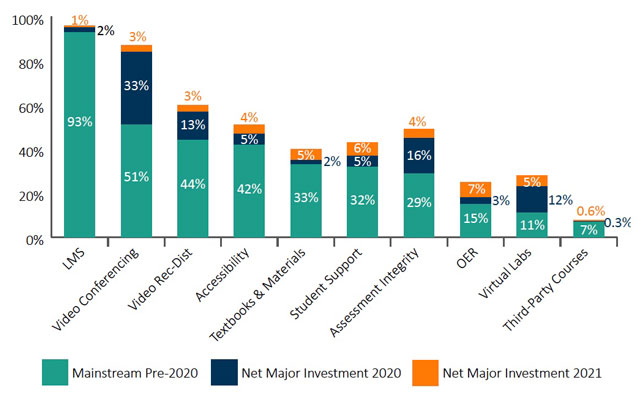
Uso de tecnologia e de métodos alternativos (como bolas no lugar de cadeiras) é incentivado nas escolas da Finlândia (Foto: Divulgação BBC)
Espaço de partilha de acontecimentos e ideias sobre ensino a distância, elearning e comunidades virtuais de aprendizagem.

Uso de tecnologia e de métodos alternativos (como bolas no lugar de cadeiras) é incentivado nas escolas da Finlândia (Foto: Divulgação BBC)


In 2020-2021, the majority of college students (58 percent) used digital course materials more than in the previous year, according to a survey from the National Association of College Stores (NACS). Just 6 percent of students said they used digital materials less.




Mainstream education technology adoption: Pre-2020, 2020 and 2021. Source: "The Changing Landscape of Online Education, 2021" from Quality Matters and Eduventures Research.


Learning loss is real and needs to be addressed, but how we go about it should be commensurate with the size of the moment.
Despite the understandable skepticism—and all the adjustments and sacrifices we've grown accustomed to—a sort of miracle is materializing in the distance. Published reports from the Centers for Disease Control suggest that the vaccines are doing their slow, steady work, and just a few days ago the state of California announced that they expect to be “fully back to business by June 15.” The siege appears to be lifting, and this time a full return to schools across the nation, while perhaps months away, is almost certainly not a mirage.
Despite a string of controversies and the public’s relatively negative sentiments about aspects of social media, roughly seven-in-ten Americans say they ever use any kind of social media site – a share that has remained relatively stable over the past five years, according to a new Pew Research Center survey of U.S. adults.

Many students have struggled with reliable internet access during the pandemic, according to a new report from Educause. The association for IT professionals in higher education surveyed 8,392 students from 54 United States institutions about their experiences with technology in fall 2020 — their learning environments, instructors' use of technology, problems with devices or connectivity, and more. Overall, 36 percent of respondents said they sometimes, often or always struggled to find an internet connection that met their academic needs; that share jumped up to 62 percent for students in unstable housing situations. And students in rural areas had more connectivity issues than those in suburbs, towns and cities.

There's a lot that faculty have done right teaching with technology during the COVID-19 pandemic — but there have also been times when technology use has been subpar. In a recent Educause survey, the majority of students reported that their instructors communicated and used technology effectively in their courses, whether learning took place online, face-to-face, synchronously, asynchronously or some combination thereof. At the same time, technology glitches and pedagogical misfires have at times led to more negative student experiences.
